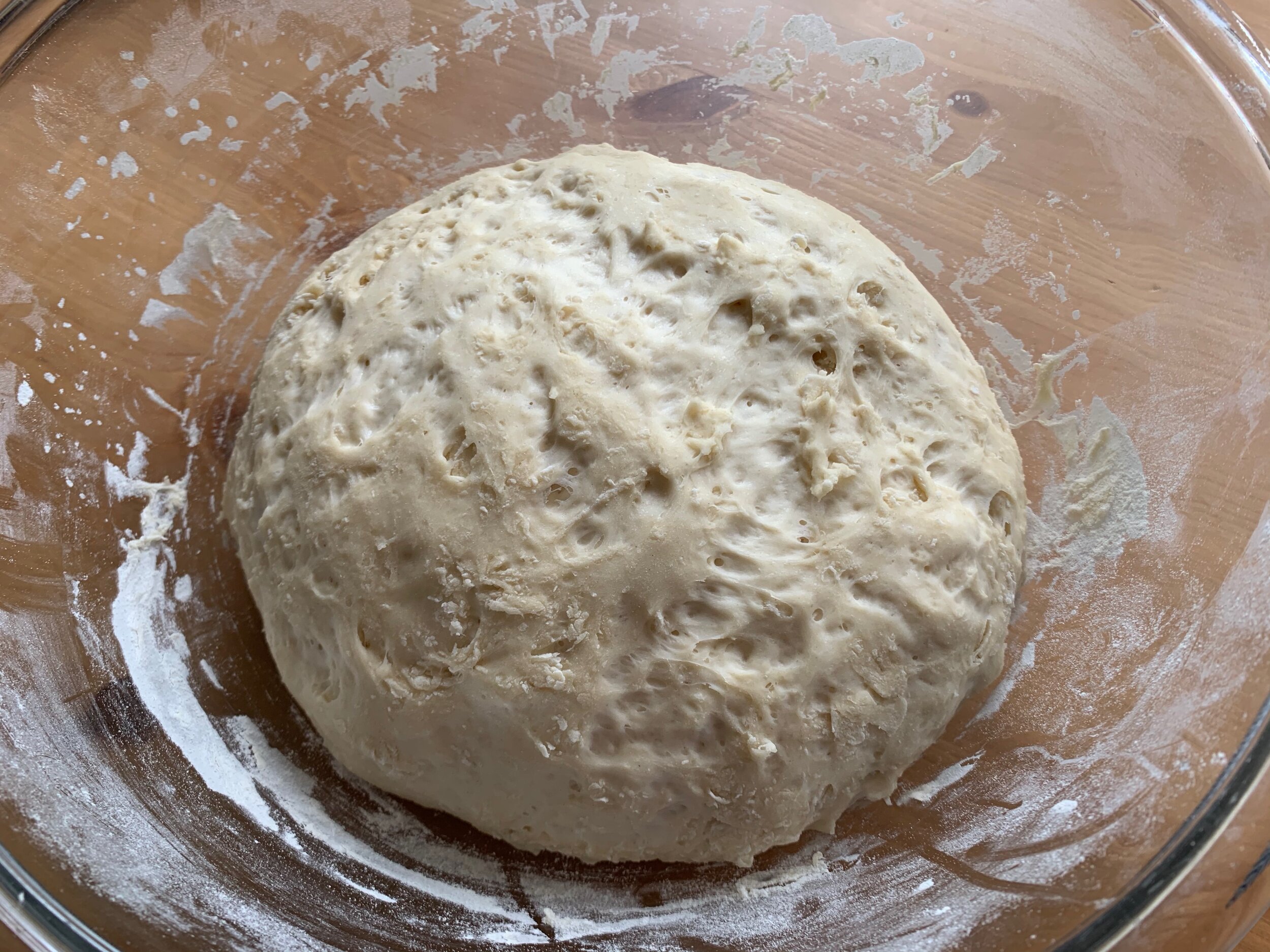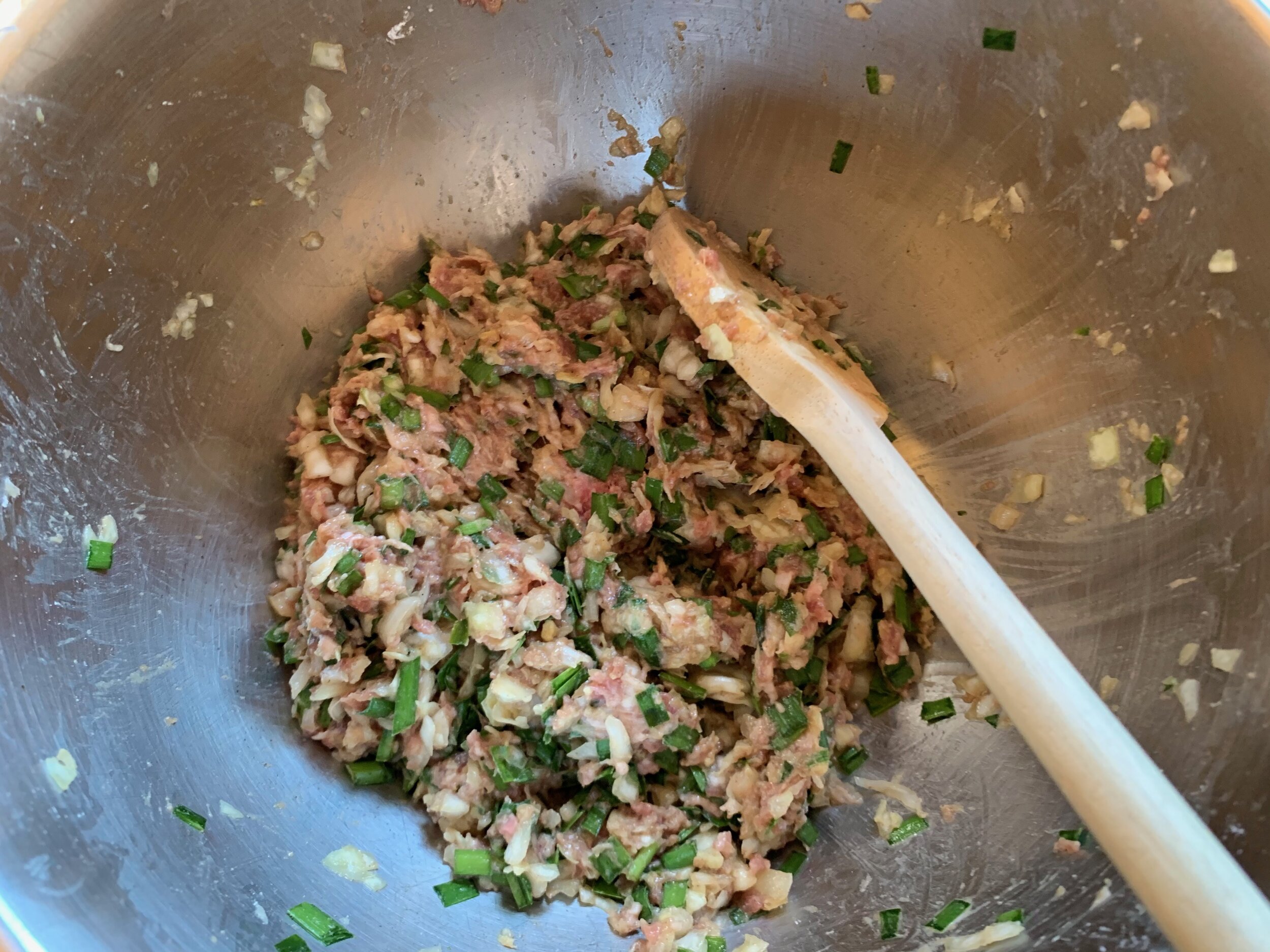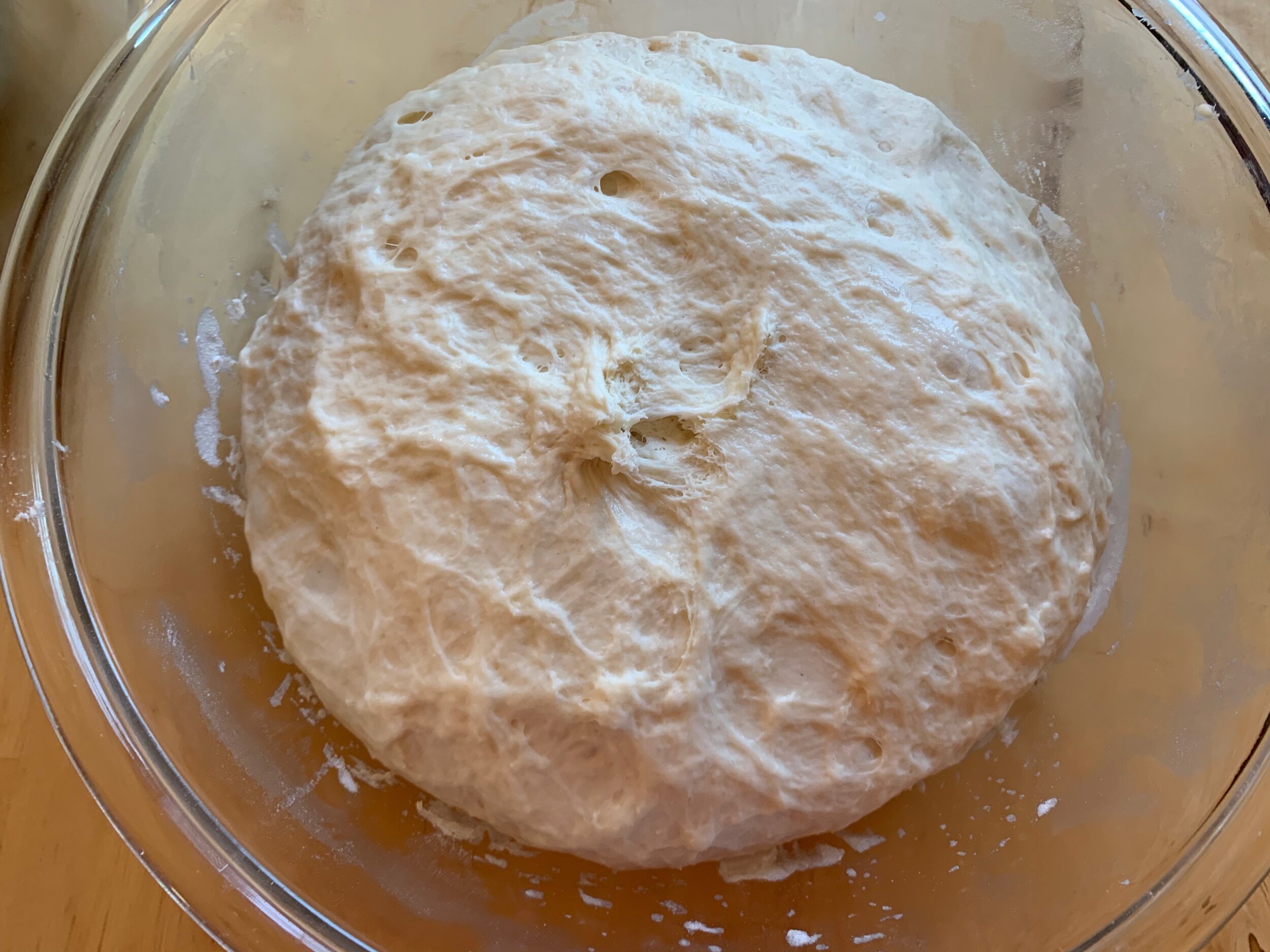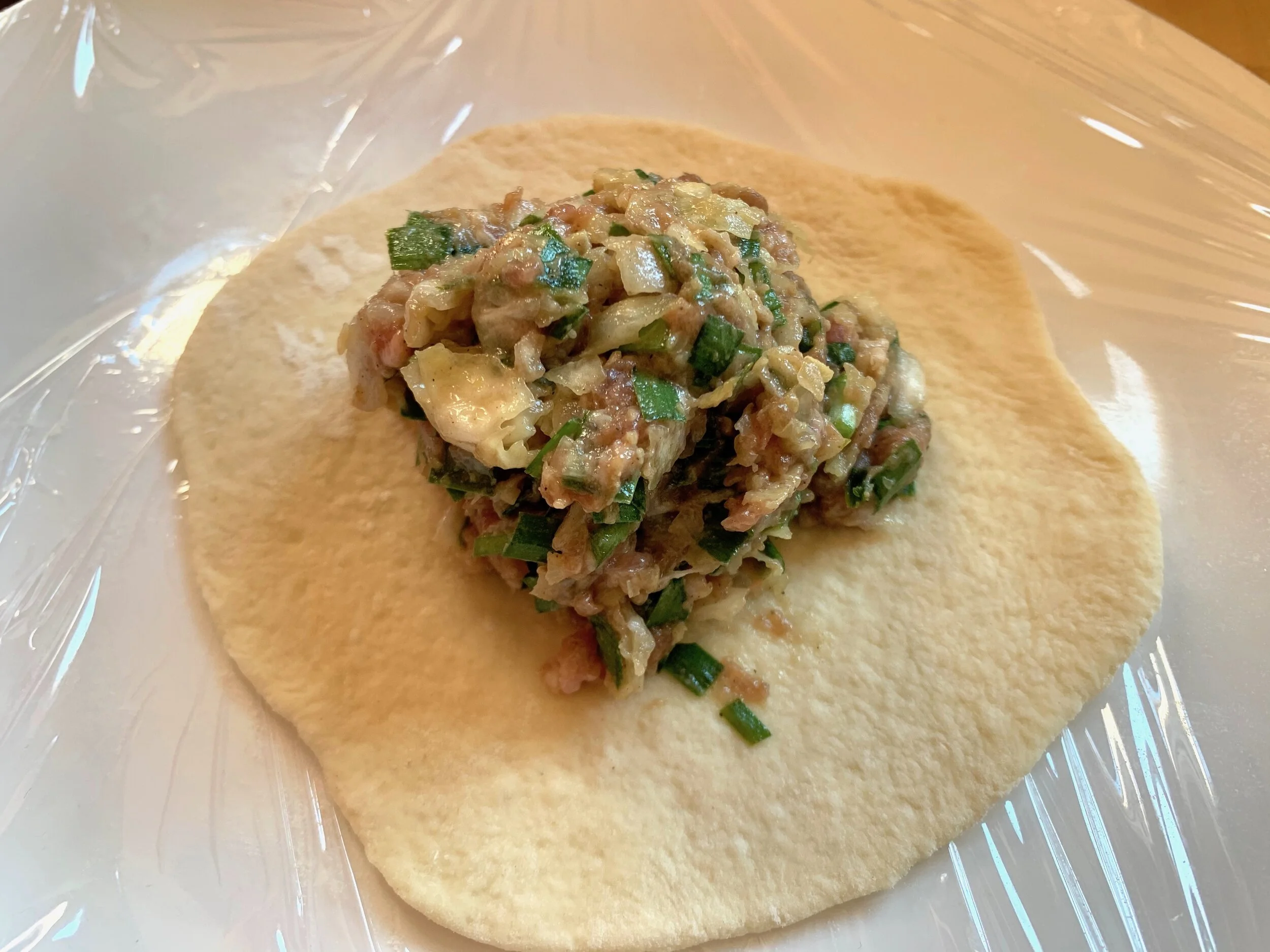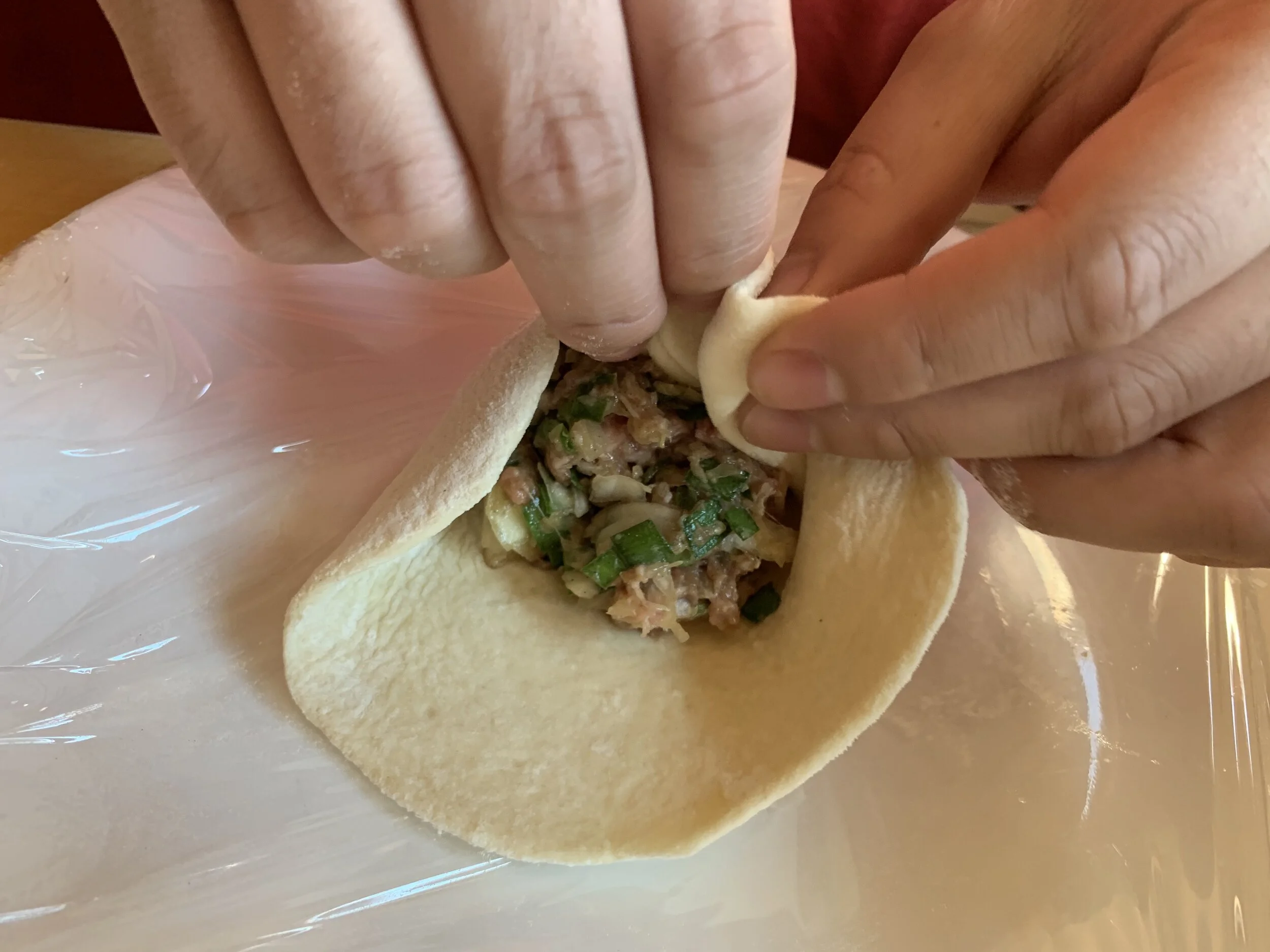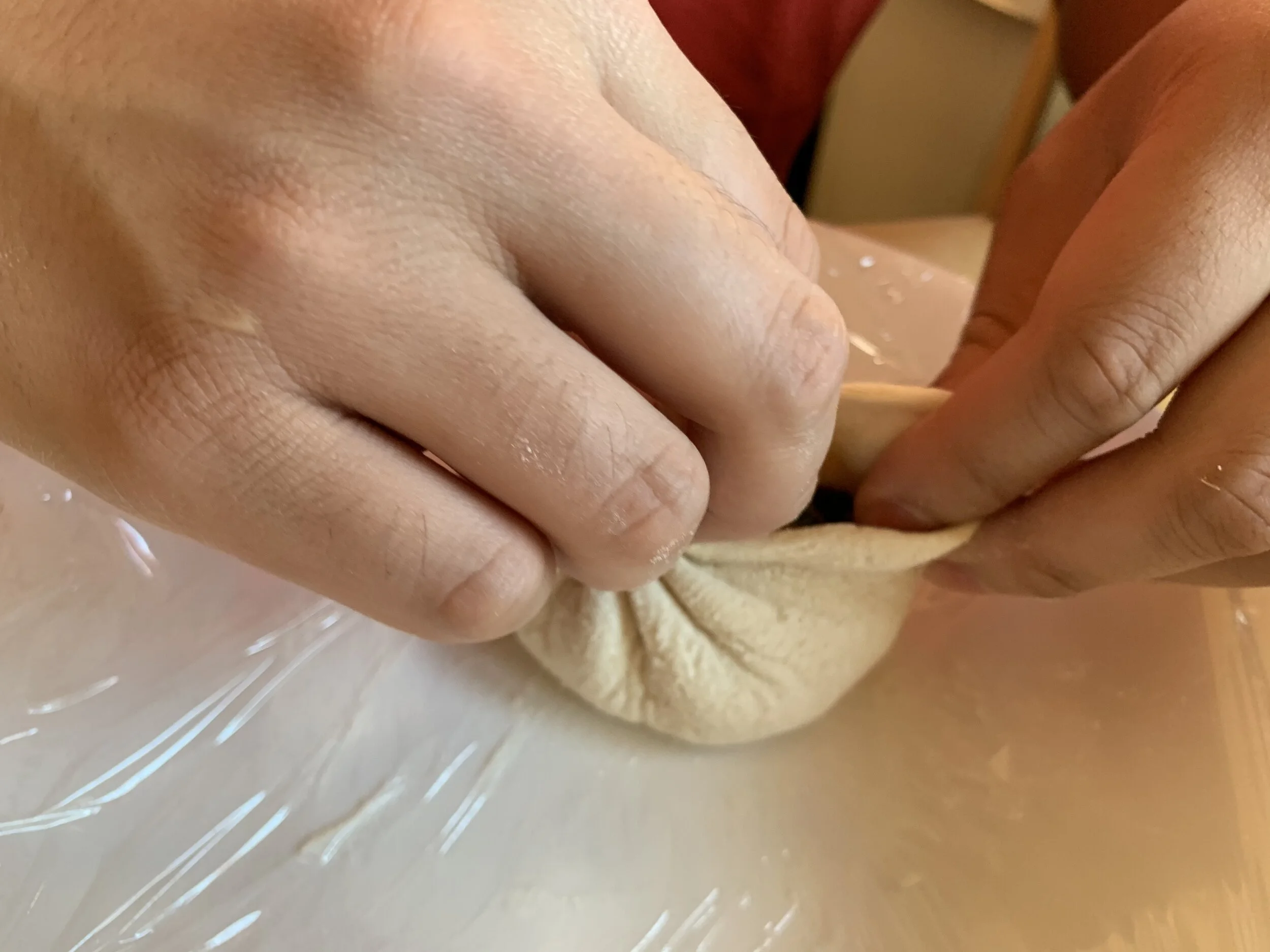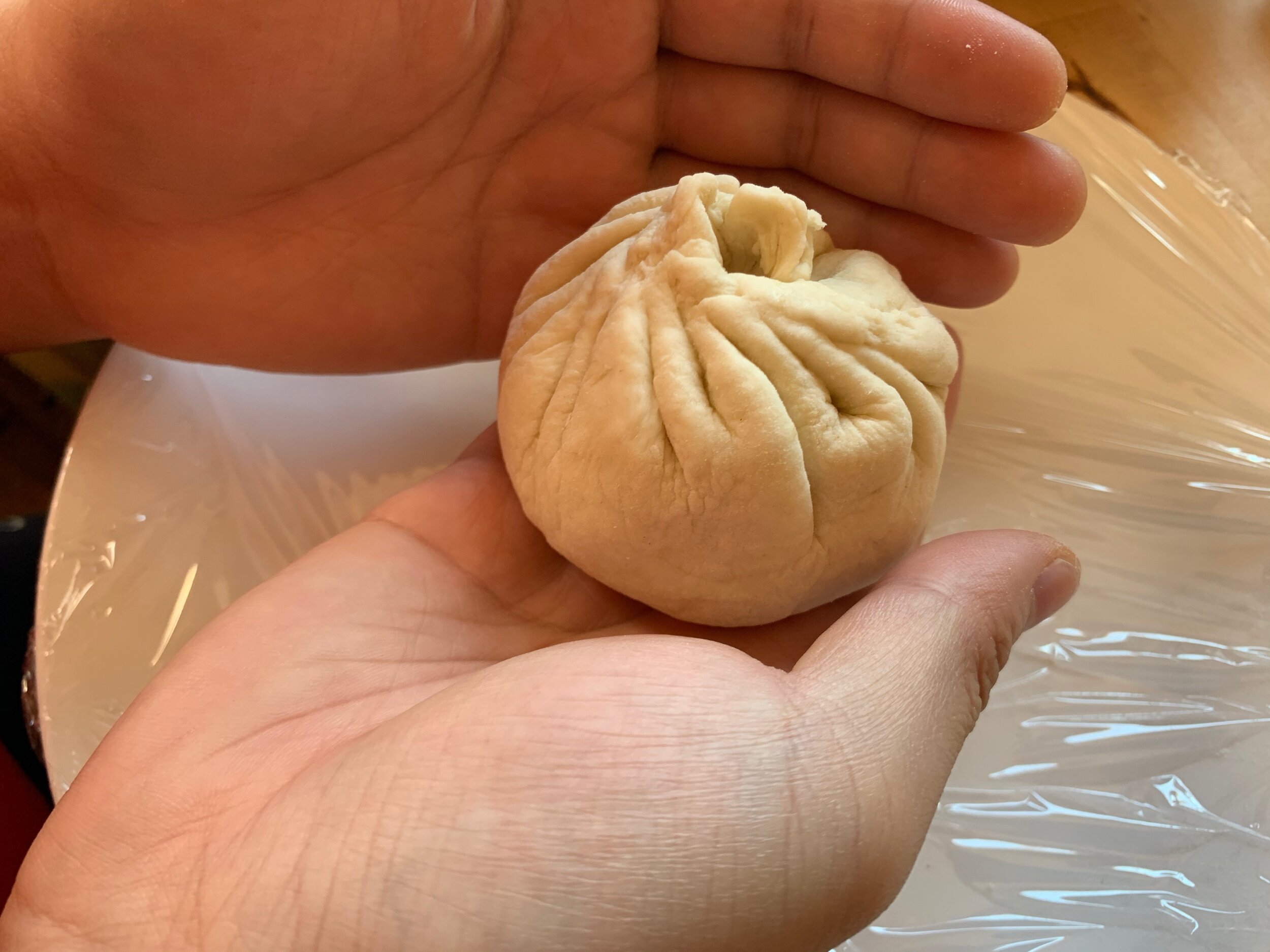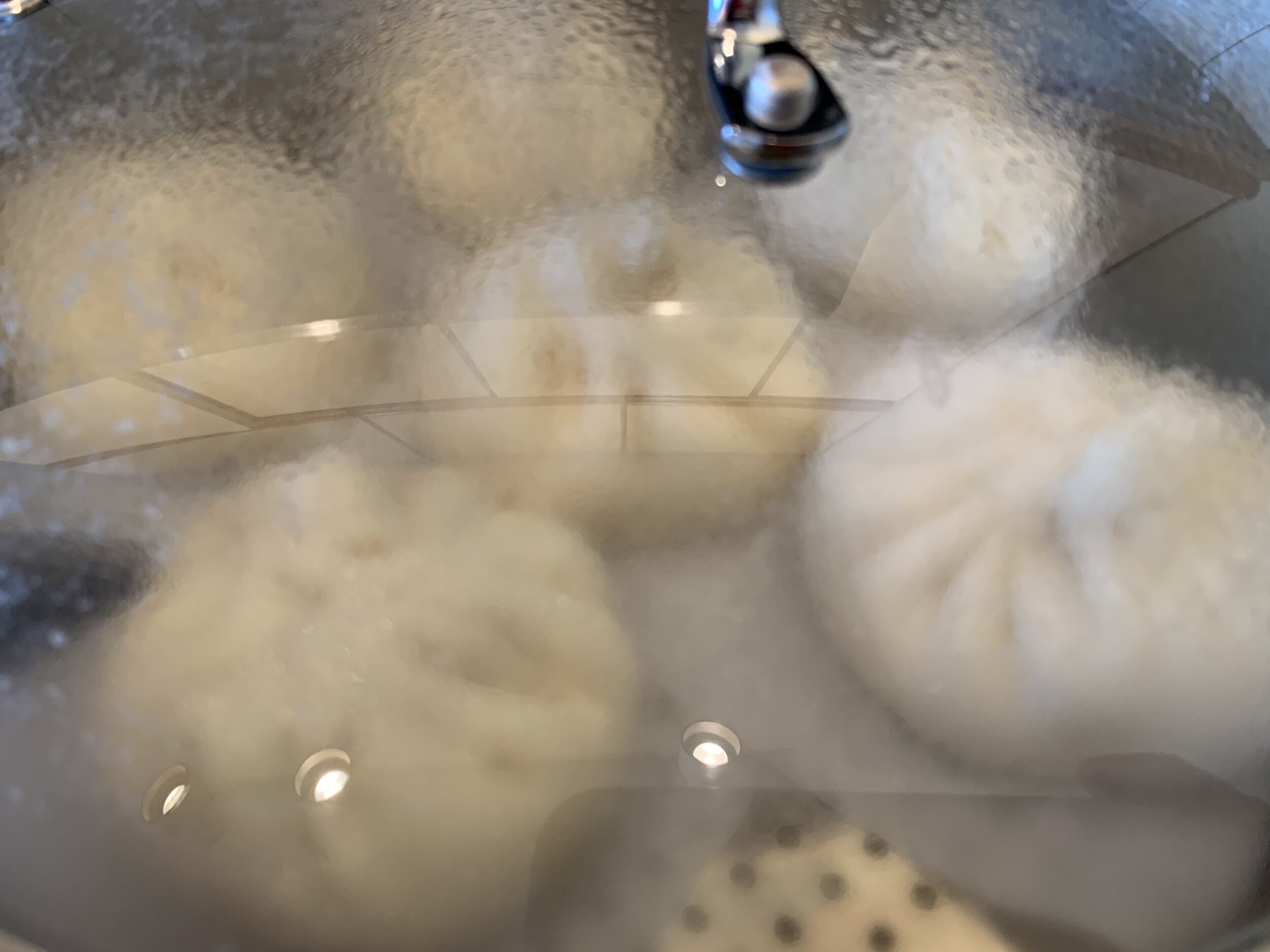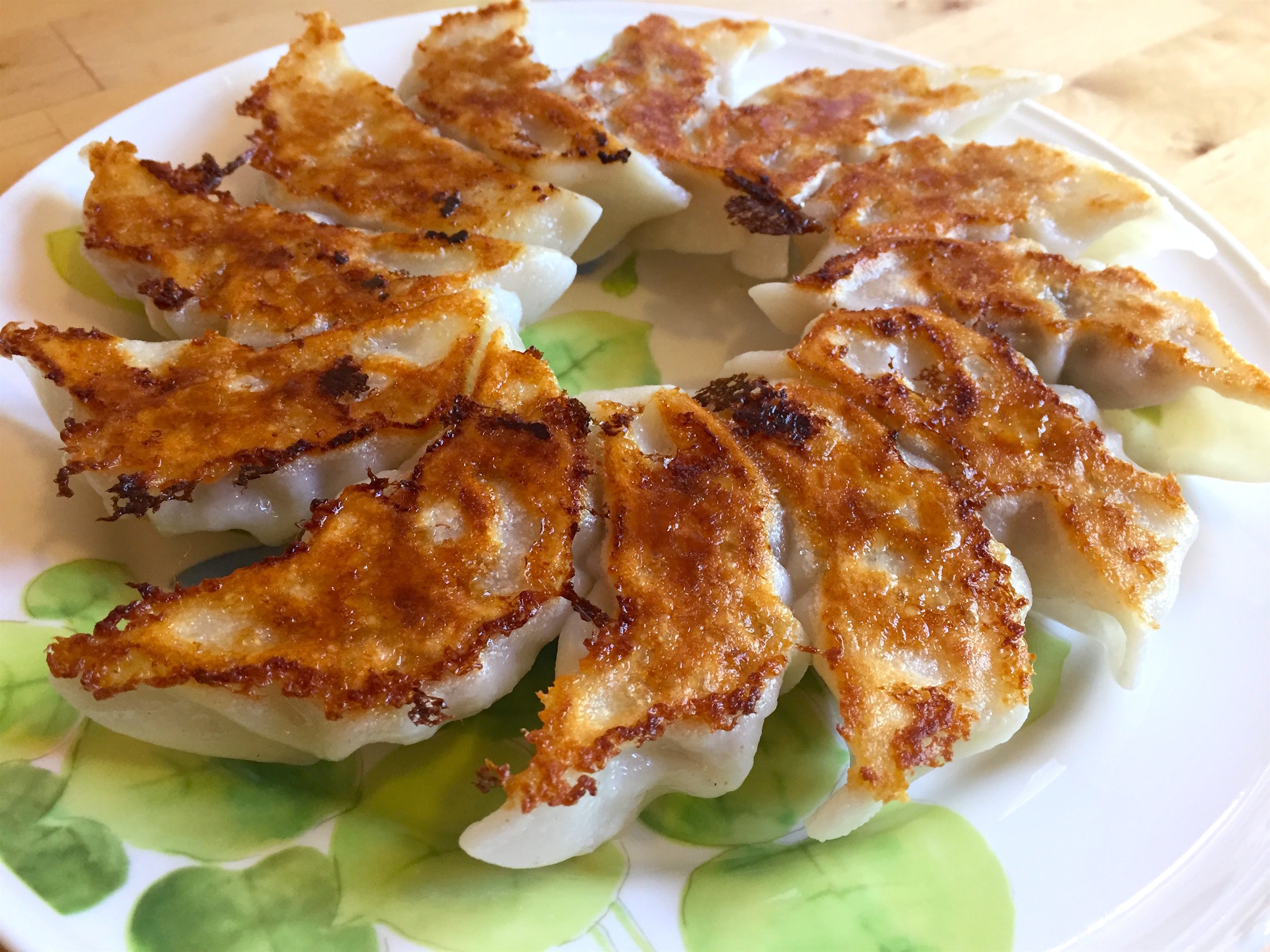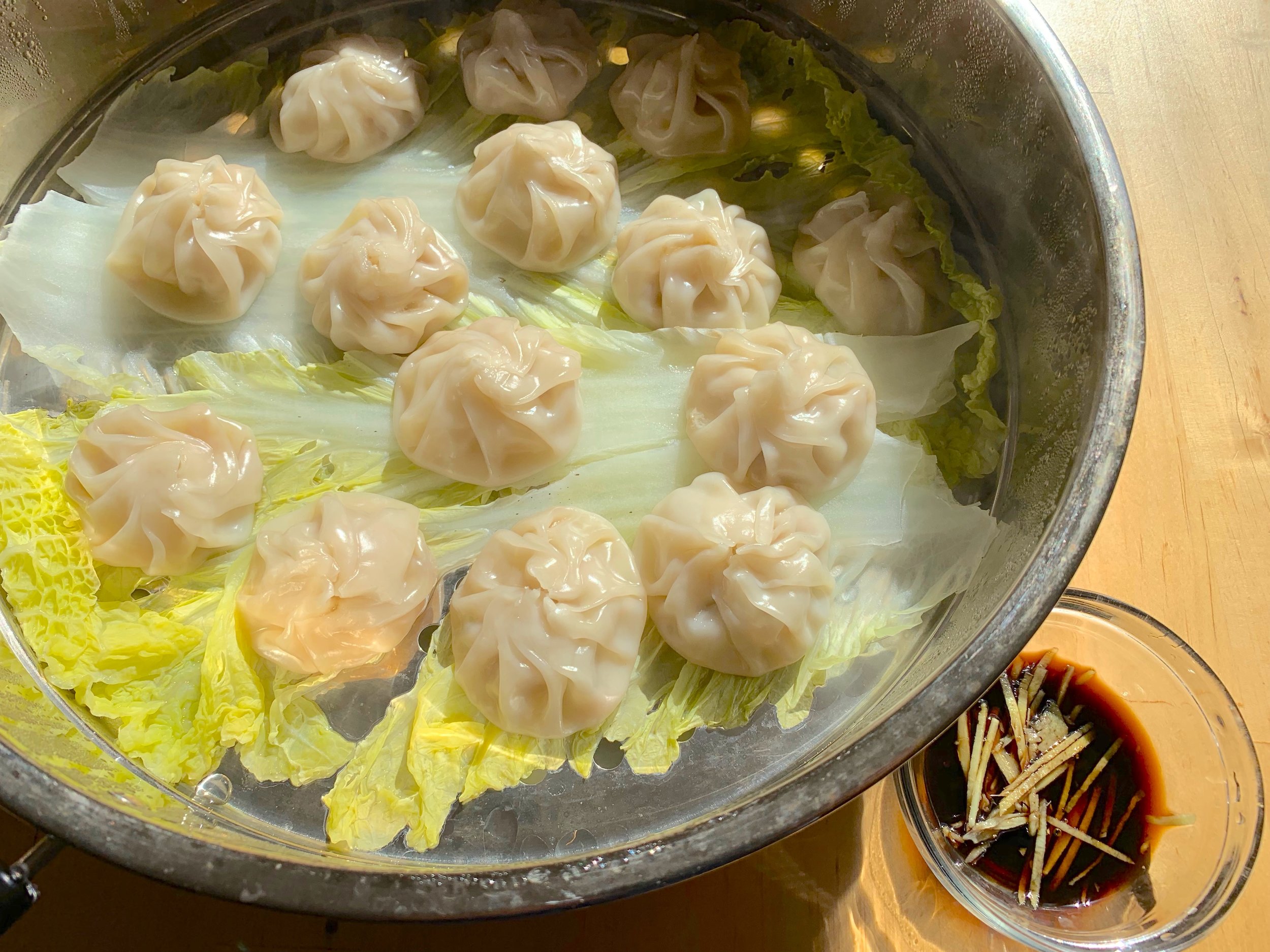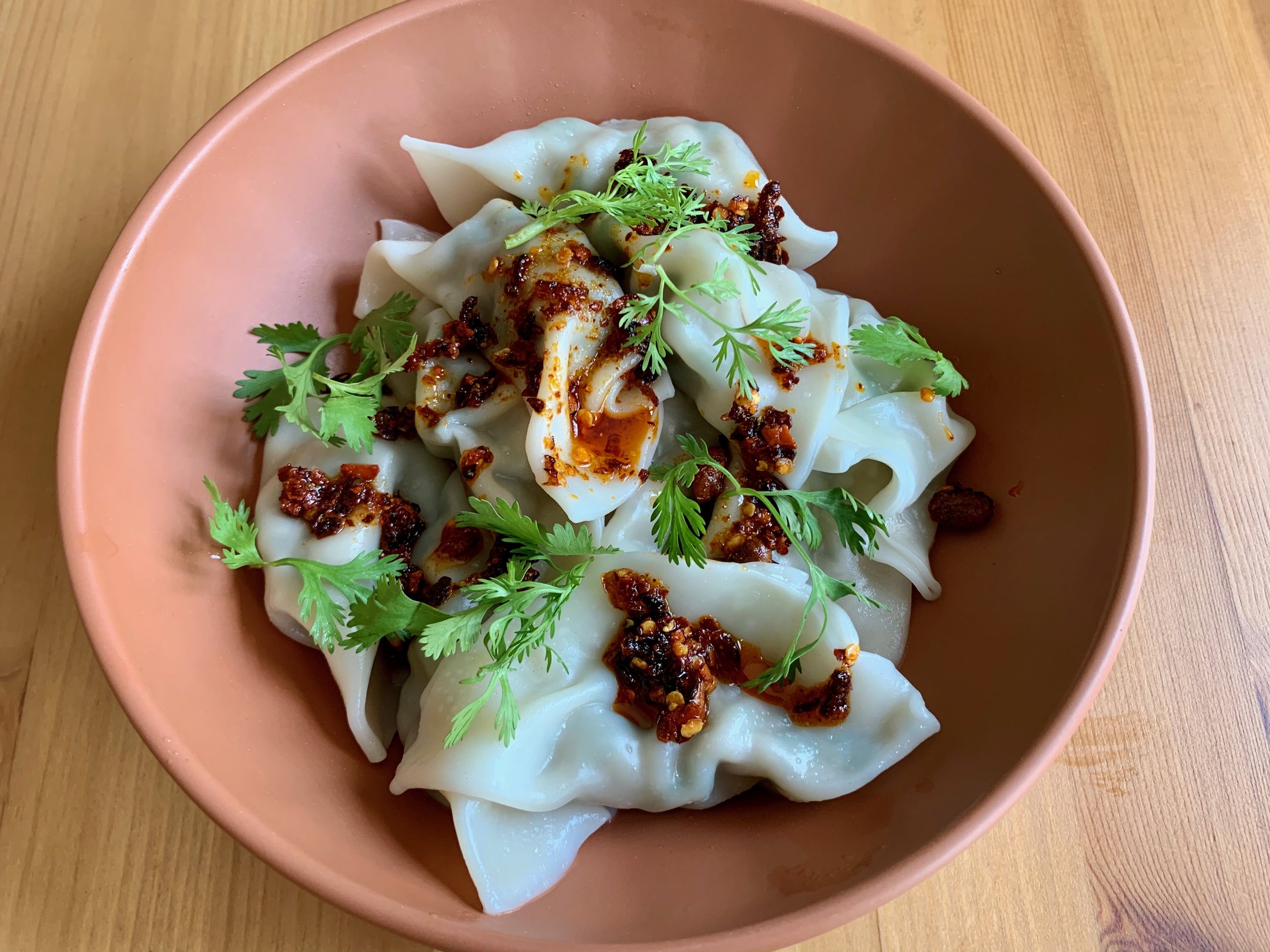Steamed Pork and Cabbage Buns

豬肉高麗菜包子 (Zhu Rou Gao Li Tsai Bao Zi)
Bao zi (包子) are yeast-leavened wheat flour buns. Especially popular in Northern China, where the agrarian economy was historically wheat-based rather than rice-based, there are now countless varieties of bao, with meat, vegetable, or even sweet fillings. Likely an evolution of steamed mantou (饅頭) breads, [1] filled bao have been around for millennia. Legend has it that bao zi were invented by Zhuge Liang during the Three Kingdoms era. [2] While leading the Shu army on campaign, Zhuge Liang came upon a wide, swift river. The locals said that to safely cross the river, a sacrifice of severed heads must be offered to the river gods. Unwilling to sacrifice more lives than necessary, Zhuge Liang instead ordered his men to wrap animal meat in dough, to resemble human heads. These bao zi were then thrown into the river as a symbolic sacrifice, and the army proceeded to ford the river. While this story is almost certainly apocryphal, it does suggest that the bun—the ideal food for a solider on the march—spread through ancient China on the backs of armies.
The bun we are making today is filled with pork, cabbage, and garlic chives. These juicy, peppery buns are an example of a da bao (大包), or “big bun,” just one of which is a complete meal. It is often eaten as a convenient breakfast on the go!
Ingredients
For the Dough
4 cups (480 g) flour
1⅓ cup warm water
2¼ tsp (7 g) yeast
1 tbsp (12 g) sugar
As always when working with yeast, first we have to prime the yeast by mixing it with warm water and 1 tablespoon sugar. This process wakes the yeast up from its suspended animation and allows it to begin metabolizing (and thus producing carbon dioxide) in a comfortable environment before the flour is introduced. Most modern commercially available yeasts are fairly robust to a wide range of priming temperatures, but the ideal water temperature is 95-100°F for fresh yeast, and 105-110°F for active dry yeast or instant yeast. Do not use boiling water, which can kill the yeast.
Mix the priming solution until uniform in color and bubbles begin to form, signaling the start of gas production. Then add the flour to the bowl, and mix with a pair of chopsticks until the dough begins to come together. When the dough becomes too difficult to mix, flour your hands and knead the dough for 5 minutes, until it forms a smooth ball. The dough should be on the wetter and stickier side, but if the dough is unmanageable, add a bit of flour.
Cover the dough with plastic wrap or a clean tea towel and let rise for 30 minutes. Then punch the dough down, knead for 3 minutes, and let it rise again, covered, until doubled in size. This should take about 60-90 minutes, but the timing of this second rise will depend on the temperature and humidity of your environment, so it is best to go by size rather than just by time. Why two rises? Punching the dough down removes some of the larger gas bubbles created by the yeast, and doing it twice will give us a finer crumb with fewer big air pockets, which is what we want for these buns.
While we wait for the dough to rise, we can prepare our filling. My go-to cabbage for this recipe is Taiwanese cabbage, a sweet and tender variety easily recognized by its flat shape.[3] However, Napa cabbage works well as a substitute, as does green cabbage. Wash and finely chop the cabbage (we are looking for pieces smaller than 1 cm in every dimension). Place the chopped cabbage in a large bowl, and sprinkle over 3 teaspoons of salt. Mix the salt in with the cabbage, and set aside for 10-15 minutes. The purpose of the salt is to draw moisture out of the cabbage, reducing the amount of water that will end up in the bun filling.
Ingredients
For the Filling
1 lb ground pork
12 oz cabbage
6 oz garlic chives, chopped
1 inch ginger, minced
2 tbsp cornstarch
2 tbsp soy sauce
1 tbsp sesame oil
1 tbsp Shaoxing rice wine (optional)
1 tsp white pepper
3 tsp salt
In a second bowl, combine the ground pork, chopped chives, minced ginger, white pepper, soy sauce, sesame oil, rice wine, cornstarch, and chopped scallions. After 10-15 minutes, the salt will have done its work on the cabbage. With a tea towel or clean hands, squeeze the cabbage dry. By the time you are done, no liquid should be coming out of the cabbage, and the total volume should have shrunk dramatically. Add the cabbage to the pork mixture, discarding the water. Mix the cabbage with the pork using a large spoon or clean hands, until the mixture is homogeneous. Set the filling aside—if you are still waiting on the dough, store the filling in the refrigerator.
When the dough has doubled in size, punch it down again, kneading several times to ensure that all large air bubbles have been worked out. Then divide the dough into 16 equal pieces. The easiest way to do this is to divide the dough first into halves, then rolling a half out into a long cylinder and dividing it into 8 equal pieces. Keep the dough pieces covered to prevent them from drying out.
Fetch your filling, and get ready to wrap the bao zi. The dough can dry out quickly, so I recommend making one wrapper, then immediately folding the bao before making the next wrapper. Alternately, if you have two sets of hands, one person should make the wrappers while the second person wraps. Remember that we are working with a live dough, so taking too long to wrap the buns will result in overproving. To avoid this fate, you can take a maximum of 30 minutes to wrap all of the buns. If you are a bun-making novice, the best way to come in under the time limit is to dispense with any fancy pleating and just pinch the dough together—they will still taste great!
Dust your work surface with flour to prevent the dough from sticking. Then take one piece of dough and roll it into a ball with your hands. Then press the dough with your palm into a round disk. Both of these steps help keep your wrapper circular—important when you start to pleat! With a rolling pin, roll the dough into a circle about 5 inches wide. I recommend using a Chinese or French style rolling pin, which both give you more control than American rolling pins. We want the edges of the wrapper to be thinner than the middle. That way, after we pleat the top, we still have about the same dough thickness everywhere. If you skip this, the top of the bun will end up with much thicker dough, and may not cook properly.
Brush any excess flour off of the wrapper, then place 3 tablespoons of pork filling in the center of the wrapper. Form this filling into a ball shape. It will serve as a rough guide for the shape of the whole bun as we begin to pleat.
Now comes the trickiest part of making the buns—the pleating. This step is entirely aesthetic—as mentioned earlier, simply pinching the dough together works just as well. Just make sure that there is no air inside the bun, which can cause it to burst when steamed. If you want your buns to look the way they do in Chinatown bakeries, though, here is how to do it. Pinch the edge of the dough with the thumb and index finger of your dominant hand, and, holding the dough, raise your dominant hand so that your thumb is just above the center of the ball of filling. Your dominant thumb will not move from this position until the wrapping is almost done—this will center the pleats.
With your non-dominant hand, pinch the wrapper about 1 inch away from where your dominant thumb is. Bring the second pinch of dough close to the first, then quickly grab the second pleat with your dominant index finger. Then grab the next bit of wrapper with your non-dominant hand and repeat. The job of your non-dominant hand is to grab new pleats and bring them to the center, keeping the dough taut to avoid trapping any air. The job of your dominant hand is to accumulate all the pleats, holding them together.
Continue pleating. As you work around the circumference of the dough, turn the bun with your non-dominant hand, rather than moving your dominant hand. Continue until you have gathered up the entire circumference of the bun in your dominant hand. Then, without letting go of the pleats, pick the bun up with your non-dominant hand. Using your non-dominant hand, twist the bun about your dominant index finger in the direction of the pleats for at least one whole revolution (counterclockwise if you’re right handed, clockwise if you’re left handed). This will create a uniform ridge of excess dough, and should result in a small indentation in the center of the bun, where your index finger was. Getting these pleats right will take some practice!
Repeat making wrappers and folding buns until all the buns are made. Place the buns on individual squares of parchment paper, and let them prove uncovered for 30 min-1 hour, or until the buns double in size. The buns will grow again during this final rise, so be sure the buns are at least 1 inch apart! This final proof is done uncovered, which dries out the surface of the dough slightly. This helps prevent the buns from sticking to each other, and makes the pleats more distinctive.
Bring some water in your steamer to a boil. Once the buns are done proving, steam them for 12 minutes. Then kill the heat and let the buns rest in the steamer for 5 minutes without removing the lid before serving. If the buns collapse after steaming, this is a sign that the dough was overproved—adjust the proving time accordingly for your atmospheric conditions.
Homemade buns freeze very well after being cooked. You can reheat them for service by steaming, or by wrapping a bun loosely with a damp paper towel and then microwaving it for about a minute.
Substitutions
There are many bun fillings out there, so feel free to experiment with this one. Mushrooms, bamboo shoots, or cooked greens are all easy substitutions. Ground chicken can be substituted for the pork in this recipe as well. Most dumpling fillings can also be used for making buns. If you want to make small buns (小包), divide the dough into more pieces, and roll to 3-4 inches in diameter.
[1] Man tou (饅頭) are steamed yeast-leavened breads. In modern Mandarin, “man tou” refer exclusively to breads without filling, with “bao zi” referring to filled buns. In historical written Chinese, however (and in some modern dialects such as Wu), “man tou” refers to both the filled and unfilled varieties. This complicates the historiography significantly.
[2] Zhuge Liang (諸葛亮) (181-234 CE) was the chief military advisor to Liu Bei (劉備), leader of the Shu Han during the Three Kingdoms period. As with many of the historical figures of the time, Zhuge Liang features heavily in the historical novel Romance of the Three Kingdoms (三國演義), written in the 14th century. In Chinese culture, Zhuge Liang is now synonymous with loyalty, intelligence, and strategic thinking. However, the real historical figure has largely been overshadowed by his fictional counterpart in cultural conversation, much as Shakespeare’s histories have done to men like Henry V and Richard III.
[3] As with every food carrying a country’s name, This cabbage isn’t called by this name in Taiwan. Rather, it is known as Li-Sun cabbage.
Recipe
Prep Time: 1 hr Cook Time: 20 min Total Time: 4 hr 20 min
(+3 hrs inactive)
Difficulty: 4/5
Heat Sources: 1 burner
Equipment: rolling pin, steamer, parchment paper
Servings: 16 buns
Ingredients
For the Dough
4 cups (480 g) flour
1⅓ cup warm water
2¼ tsp (7 g) yeast
1 tbsp (12 g) sugar
For the Filling
1 lb ground pork
12 oz cabbage
6 oz garlic chives, chopped
1 inch ginger, minced
2 tbsp cornstarch
2 tbsp soy sauce
1 tbsp sesame oil
1 tbsp Shaoxing rice wine (optional)
1 tsp white pepper
3 tsp salt
Instructions
1. Add the warm water to a large bowl, and add the yeast and sugar. Mix until uniform in color and bubbles begin to form.
2. Add the flour to the bowl, and mix together with a pair of chopsticks until the dough begins to come together. Flour your hands and knead for about 5 minutes, until the dough is smooth. The dough should be on the wetter and stickier side, but add a bit of flour if the dough is unmanageable. Let rise, covered, for 30 minutes.
3. Punch down the dough, knead for 3 minutes, then let the dough rise again, covered, until doubled in size, about 60-90 minutes.
4. While the dough rises again, finely chop the cabbage, and place in a large bowl with 3 tsp of salt. Leave the cabbage for 10-15 minutes, so the salt will draw out some of the moisture.
5. In a second large bowl, combine the pork, chopped chives, minced ginger, white pepper, soy sauce, sesame oil, rice wine, cornstarch, and chopped scallions.
6. Squeeze the cabbage to remove excess water. Then add the cabbage to the pork bowl, mixing to complete the filling.
7. When the dough has doubled in size, punch it down again, kneading a couple of times to ensure that all large air bubbles have been worked out of the dough.
8. Divide the dough into 16 equal pieces. Keep the dough pieces covered to prevent them from drying out.
9. To make a wrapper, roll a piece of dough into a ball with your hands. On a work surface dusted with flour, press the dough into a round disk. With a rolling pin, roll the dough into a circle about 5 inches wide, with the edges thinner than the middle. Brush off the excess flour.
10. Place 3 tablespoons of pork filling in the center of the wrapper, and shape the filling into a ball.
11. To wrap, Pinch the wrapper together to form a pleat, then fold again to form another pleat. Continue until you have worked your way around the entire bun, then twist the pleats together to make a tight seal.
12. Repeat steps 9-11 until all buns are made.
13. Place the buns on individual squares of parchment paper, and let them prove uncovered for 30 min-1 hour, until doubled in size.
14. Place the buns in a steamer basket with their parchment paper. Bring the water in the steamer to a boil.
15. Steam the buns for about 12 minutes. When the buns are done, let rest in the steamer for 5 minutes before removing the lid and serving.







